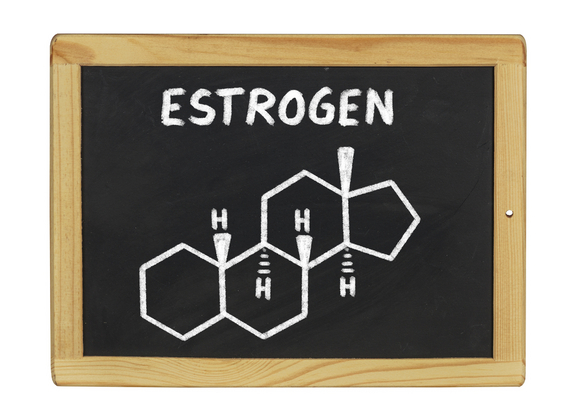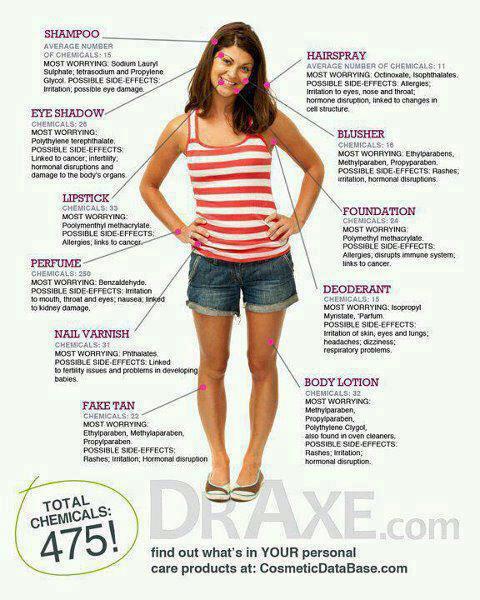Xenoestrogens are environmental estrogens and they are more abundant than you think. Most natural therapists believe that xenoestrogens play a huge part in the breast cancer epidemic we are currently experiencing.
Xenoestrogens disrupt our endocrine (hormonal) systems. Estrogen, like every hormone naturally produced by the body, is a much needed chemical messenger that transports a signal from one cell to another. The problem with xenoestrogens is that they mimic the effects of estrogen and compromise normal hormone function.
Combined with the estrogen naturally produced by the body, these foreign chemicals create an excess of estrogen (which has come to be known as “estrogen dominance”).
Since we know that breast cancer develops in the presence of estrogen maintained over a prolonged period of time, this puts both women and men at risk for developing the disease.
Research shows that xenoestrogens are linked to high rates of breast cancer, and also to endometriosis, an unusually early onset of puberty, infertility, and miscarriages.
In men, xenoestrogens are believed to contribute to decreased sperm counts, and prostate and testicular cancers.
Other health problems such as thyroid disorders, diabetes, and behavioral abnormalities in children, may also be linked to xenoestrogens interfering with the estrogens naturally produced by the body.
Because there are so many xenoestrogens in our cleaning products and gardening chemicals (which eventually get into the water supply), we are now finding that the reproductive systems of fish and amphibians have been affected.
Estrogen Dominance
Estrogen dominance occurs when the ratio of estrogen to progesterone sways too much one way or another. One of the most common patterns with estrogen dominance is to see an excess of estrogen in relation to progesterone, which is often too low. Estrogen and progesterone work together like a system of checks and balances to achieve hormonal balance in both men and women.
Estrogen is an active hormone that is actually able to increase the production of its own receptors. It stimulates tissue to grow. When left unchecked (due to inadequate progesterone levels), it can stimulate tissue to grow inappropriately, especially in the breast.
How to Protect Yourself
Take a close look at the products you use on a daily basis – begin by checking the ingredients in your cleaning products (if they don’t have a list of ingredients, try to find them on-line), your personal care products like shampoo, conditioner, sunscreen, facial care products, deodorants, etc. because this is where many xenoestrogens are commonly found. Doesn’t that make you mad?
Reduce your exposure to chlorine by using a shower head filter that filters out chlorine. Choose unbleached products.
Limit your use of plastics, especially drinking from plastic water bottles and microwaving in plastic containers.
Learn to identify and minimize as many xenoestrogens as possible.
Chemicals That Have Estrogenic Effects
-
Alkylphenol
-
Atrazine (weed killer)
-
4-Methylbenzylidene camphor (4-MBC) (sunscreen lotions)
-
Benzyl Benzoate (fragrance ingredient, artificial flavor, preservative, and solvent)
-
Butylated hydroxyanisole / BHA (food preservative)
-
Bisphenol A (monomer for polycarbonate plastic and epoxy resin; antioxidant in plasticizers)
-
Chlorine and chlorine by-products
-
Dichlorodiphenyldichloroethylene (one of the breakdown products of DDT)
-
Dieldrin (insecticide)
-
Dimethicone (a plasticizer used in many products)
-
DDT (insecticide)
-
Endosulfan (insecticide)
-
Erythrosine / FD&C Red No. 3
-
Ethinylestradiol (combined oral contraceptive pill)
-
Heptachlor (insecticide)
-
Lindane / hexachlorocyclohexane (insecticide)
-
Metalloestrogens (a class of inorganic xenoestrogens)
-
Methoxychlor (insecticide)
-
Nonylphenol and derivatives (industrial surfactants; emulsifiers for emulsion polymerization; laboratory detergents; pesticides)
-
Pentachlorophenol (general biocide and wood preservative)
-
Polychlorinated biphenyls / PCBs (in electrical oils, lubricants, adhesives, paints)
-
Parabens (methylparaben, ethylparaben, propylparaben and butylparaben commonly used as preservatives in personal care products)
-
Petroleum jelly (a by product of the petroleum industry)
-
Phenosulfothiazine (a red dye)
-
Phthalates (plasticizers)
-
DEHP (plasticizer for PVC)
-
Propyl gallate
-
Sodium Lauryl Sulphate (a foaming agent used in shampoos and toothpastes)
-
Sodium Laureth Sulphate ( ” )
That’s a big long list of baddies and it’s not even a complete list! For a truly comprehensive database of product ingredients, go to: http://www.ewg.org/skindeep/ . There you can look up the products you are using and see how they rate for safety.
Tomorrow I’ll provide you with a list of things you can do to limit your personal exposure (and also our environment) to xenoestrogens.
Sources:
http://www.energeticnutrition.com/vitalzym/estrogen_dominance.html#reading
http://www.johnleemd.com/store/breast_cancer.html
http://en.wikipedia.org/wiki/Xenoestrogen
http://breakingnews.ewg.org/2012sunscreen/
Reference: Marie Clark (.) com




